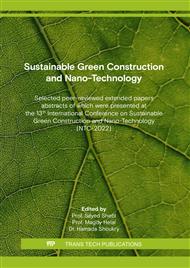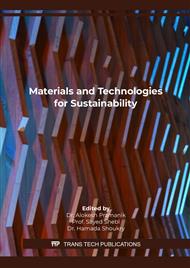[1]
McGregor, J.G. (1997). Reinforced concrete mechanics and design (3rd ed.).
Google Scholar
[2]
Jayanandana, A. D. C., and Jayasinghe, M. T. R. (1998), Design of high strength concrete with locally available materials", Master,s thesis, University of Moratuwa, Sri Lanka.
Google Scholar
[3]
A. Lotfy, M. Al-Fayez (2015), Performance evaluation of structural concrete using controlled quality coarse and fine recycled concrete aggregate, Cement Concrete Composites Journal, Vol. 61, pp.36-43.
DOI: 10.1016/j.cemconcomp.2015.02.009
Google Scholar
[4]
Akbari, Y. V., Arora, N. K., and Vakil, M. D. (2011), Effect on recycled aggregate on concrete properties,, International Journal of Earth Science and Engineering, Vol. 4, Issue 6, pp.52-57.
Google Scholar
[5]
Anikets Aphale and Sheetaz A.Sahare (2016), Efffect of Particle size of recycled Glass on concrete properties, , International Journal of Advances in Mechanical and Civil Engineering, Vol.3, Issue 5.
Google Scholar
[6]
Sekar, T., Ganesan, N., and Nampoothiri, N. V. N. (2011), Studies on strength characteristics on utilization of waste materials as coarse aggregate in concrete,, International Journal of Engineering Science and Technology. Vol. 3, Issue 7, pp.5436-5440.
Google Scholar
[7]
Hyungu, J. (2011), Processing and properties of recycled aggregate concrete,, PhD Thesis, . Illinois University, USA.
Google Scholar
[8]
Limbachiya, M. C., Leelawat, T., and Dhir, R. K. (2000), Use of recycled concrete aggregate in high- strength concrete,, Materials and Structures Journal,Vol. 33. Issue 2.
DOI: 10.1007/bf02480538
Google Scholar
[9]
M. Nematzadeh, J. Dashti, B. GanjaviOptimizing (2018), Compressive behavior of concrete containing fine recycled refractory brick aggregate together with calcium aluminate cement and polyvinyl alcohol fibers exposed to acidic environment, Construction Building Materials Journal, Vol. 164, pp.837-849.
DOI: 10.1016/j.conbuildmat.2017.12.230
Google Scholar
[10]
N. Kisku, H. Joshi, M. Ansari, S.K. Panda, S. Nayak, S.C. DuttaA (2017), Critical review and assessment for usage of recycled aggregate as sustainable construction material,, Construction and Building Materials Journal, Vol. 131, pp.721-740.
DOI: 10.1016/j.conbuildmat.2016.11.029
Google Scholar
[11]
NAHB Research Centre. (2001). Alternative materials for concrete. USA.
Google Scholar
[12]
Roz-Ud-DinNassa and Parviz Soroushian (2012), Strength and durability of Recycled Aggregate Concrete containing milled glass as partial replacement for cement,, Construction Building and Materials Journal, Vol. 29, pp.368-377.
DOI: 10.1016/j.conbuildmat.2011.10.061
Google Scholar
[13]
Messaouda Belouadah, Zine ElAbidine Rahmouni and NadiaTebbal (2019), "Experimental characterization of ordinary concretes obtained by adding construction waste (glass, marble), Procedia Computer Science Journal, Vol. 158, pp.153-162.
DOI: 10.1016/j.procs.2019.09.038
Google Scholar
[14]
Liam Hooi and Phang Min (2017), Potential of substituting waste glass in aerated light weight concrete,, Proceedia Engineering Journal, Vol 17, pp.633-639.
DOI: 10.1016/j.proeng.2017.01.398
Google Scholar
[15]
G. M. Sadiqul Islam, M. H. Rahman, and Nayem Kazi (2017), Waste glass powder as partial replacement of cement for sustainable concrete practice,, International Journal of Sustainable Built Environment, Vol. 6, pp.37-44.
DOI: 10.1016/j.ijsbe.2016.10.005
Google Scholar
[16]
Gayal Kuruppu and Ravihansa Chandratilake (2012), Use of recycle glass as a coarse aggregate in concrete,, World Construction Conference 2012 – Global Challenges in Construction Industry, 28 – 30 June 2012, Colombo, Sri Lanka.
Google Scholar
[17]
Edward Harrison, Aydin Berenjian and Mostafa Seifan (2020), Recycling of waste glass as aggregate in cement-based materials,, Environmental Science and Ecotechnology Journal, Vol. 4.
DOI: 10.1016/j.ese.2020.100064
Google Scholar
[18]
T. S. Serniabat, M. N. N. Khan and M. F. M. Zain (2014), Use of Waste Glass as Coarse Aggregate in Concrete: A Possibility towards Sustainable Building Construction,, International Journal of Civil and Environmental Engineering, Vol. 18, Issue10.
Google Scholar
[19]
O.D. Atoyeb, A.J. Gana and J.E. Longe (2020), Strength assessment of concrete with waste glass and bankoro (Morinda Citrifolia) as partial replacement for fine and coarse aggregate,, Results in Engineering Journal, Vol. 6.
DOI: 10.1016/j.rineng.2020.100124
Google Scholar
[20]
Olumoyewa Dotun Atoyebi and Obanishola M. Sadiq (2018), Experimental data on flexural strength of reinforced concrete elements with waste glass particles as partial replacement for fine aggregate,, Data in Brief Journal, Vol. 18, pp.846-859.
DOI: 10.1016/j.dib.2018.03.104
Google Scholar
[21]
Sameer Shaikh, S.S. Bachhav and D.Y. Kshirsagar (2015), Effective Utilisation of Waste Glass in Concrete,, International Journal of Engineering Research and Applications, Vol. 5, Issue 12, (Part - 4) December 2015, pp.01-04.
Google Scholar
[22]
M. Iqbal Malik, Muzafar Bashir, Sajad Ahmad, Tabish Tariq, Umar Chowdhary (2013), Study of Concrete Involving Use of Waste Glass as Partial Replacement of Fine Aggregates,, IOSR Journal of Engineering, Vol. 3, Issue 7 (July. 2013), ||V6 || PP 08-13.
DOI: 10.9790/3021-03760813
Google Scholar
[23]
Adeyemi Adesina and Sreekanta Das (2021). Development of eco-friendly engineered cementitious composites using glass aggregates: Shrinkage properties,, Cleaner Engineering and Technology Journal, Vol. 5.
DOI: 10.1016/j.clet.2021.100299
Google Scholar



